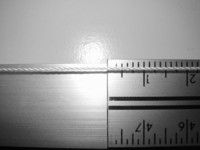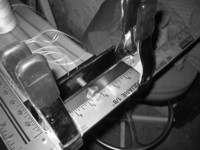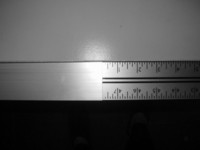chock alignment take 2
Well i got out on the ice and put the alignment plates on my runners and eager to find out how i did in the basement..
not very good.

Doctor turns to me and says, sorry dude.. Way out of alignment. (well not way, way out, but still)
Then we check out Mike's new, but older dn, and his are way closer then mine. And I tried to align mine in the shop! It's times like that, that I realize my shop skills really aren't that good...
[image:279,right]
So back to the drawing board, unglue the chocks, and realign with a better alignment method.
Surprisingly, after less then five minutes of a heat gun and a thin scraper the chock's popped right off. The epoxy had hardly stuck to the chocks. No reason not to glue when they come off that easy. A little sanding and I was good to re-epoxy.
I used 48 inch dry wall tees and a string to make a set of poor mans alignment plates. I clamped the tee to the chock and strung the string along the edge of the square. We'll see how it worked. It did show the same misalignment I was seeing out on the ice with the plates.


fine tuning makes all the difference
[image:283,right]
When he says it's good - - - tighten the bolts.
The whole process took less then 2 hours. Now I'll have to wait till I get back on the ice with the alignment plates to see if this works any better, as they say, the plates don't lie
- us5214's blog
- Login or register to post comments
- 3466 reads

Comments
Dry wall square might not be accurate
Check the squareness of the drywall squares .A simple way to check square is measure 3,4,5 'measure 3 ft one direction ,4 feet at 90 degrees and the Hypotenuse should be 5 feet .any multiple or 3-4-5 will work .
good point ~ I checked with another square
I have two other carpenter squares and I checked the dry wall tees with both of them. In addition the dry wall tees are brand new and have never been used.
all though, i like your use of math and geometry.